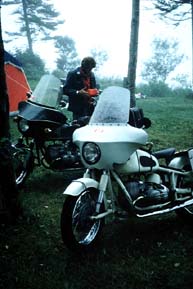Part One - The BeginningBack in the mid '70s when I started working at the National Geographic photo labs I noticed this gorgeous white BMW motorcycle with a sidecar was parked in the lot each day. The bike -- I would later learn it was an R69/2 -- was showroom new, and its aluminum parts shone like chrome despite being ridden every day. I got to know its owner and the owner of another equally pristine R69/2 who worked there. Before too long I got the bug and purchased an 1968 R60/2. This was my first motorcycle I and I didn't even know how to ride. My friend drove it home for me and taught me. Pretty easy really since you could let out the clutch slowly at idle and the bike would chug, chug, chug... The guy at the DC motor vehicle dept. was surprised when I showed up on it to take my test. Amazing bike. The connecting rods had roller bearings on the bottom end and the rods were assembled onto the crankshaft at the factory. If there was a problem with a connecting rod the entire crank/connecting rod assembly needed to be replaced. The two cylinders had push rods and easy to adjust valves. There was a magneto ignition, which meant you could still start and run the bike even if the battery and generator died. This was a good feature because the carbon brushes had a habit of wearing out at the most inopportune times. Wonderfully behaved bike too. Even in the middle of the winter I'd warm the carbs with my hands, then give it one kick to lubricate the rings, then give it solid kick and it would start. The neatest feature was the Earls front-end. The suspension consisted of a trailing arm with two spring/shock units. This geometry supplied a very smooth ride, and caused the front-end of the bike to rise up when the front brake was applied -- the inertia of the bike forced the trailing arm to spread -- shifting the weight to the back wheel and improving its braking traction. This is exactly the opposite of the nose dive on a conventional front-end. This curious geometric / inertial assist was most welcome since the only thing worse than the drum brakes on a /2 were the lights. My R60/2 was far from pretty. It had its original black paint job and had lived all of its life outdoors, so it showed its age. Despite my ugliness of my mount I become qualified to become a member of the ad hoc Washington Area Beemer, Beer, and Bullshit Bunch; a group of R6x/2 owners that got together every Thursday night to talk about Beemers, drink beer... well you get the idea. We met at Ed's in Takoma Park,MD or Mike's in Gaithersburg, MD about 20 miles away. Both Ed and Mike restored Beemers and they always had the right tool and knowledge to fix any problem. I learned most of what I know about motorcycles from those two guys and more than once they saved my bacon. Shortly after joining this merry band I got transferred to Geographic's center in Gathersburg about a mile from Mike's house. I was living in DC at the time, and Mike worked about a mile from where I lived in DuPont Circle. We would pass each other every morning on the Beltway on our respective 20 mile commutes. We both rode year-round. Mike's bike was almost identical to mine; an R60/2 which was functional, not pretty. The WABBBB was a great bunch of guys: telephone PBAX installers, photo lab technicians, a GS-12 computer programmer, a psychiatrist / college professor, a model maker from the Smithsonian, and who ever else happened to roll in that night with a six pack of Blue Ribbon. I'd always come to work the next day with at least two new jokes. Other that riding back and forth to our weekly get togethers I never recall taking a trip together as a group. That wasn't in the group charter I guess. But, one of my fondest biking memories will always coming back from Mike's, half a dozen or so R6x/2 cruising together down I-270 close to midnight at 70mph, the exhaust notes of the six engines merging together and drifting apart in a sympathetic rhythmic harmony. Next chapter: [ The Maple Leaf Rally ] [ Title Page] |
